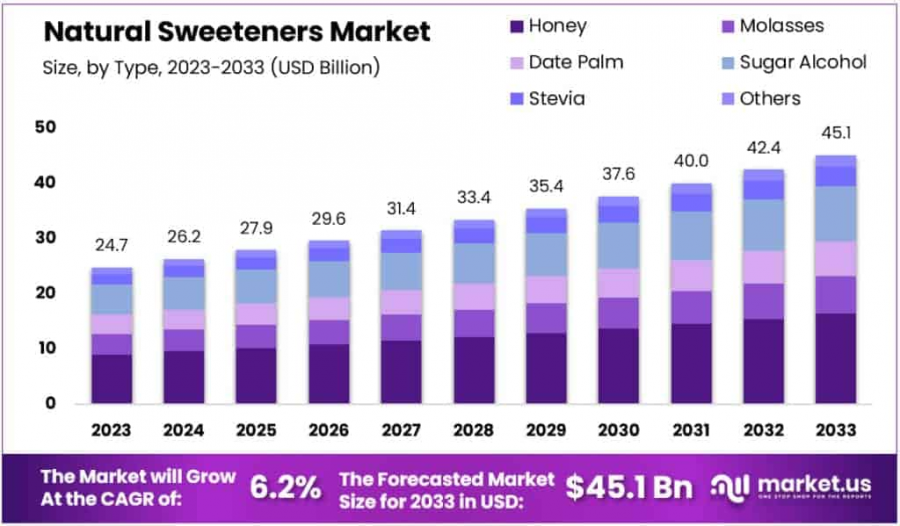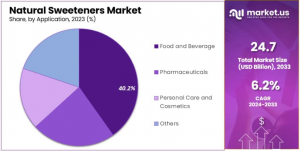
Natural Sweeteners Market to Reach USD 45.1 Billion by 2033, Growing at 6.2% CAGR
Natural Sweeteners Market size is expected to be worth around USD 45.1 Billion by 2033, from USD 24.7 Billion in 2023, growing at a CAGR of 6.2%
NEW YORK, NY, UNITED STATES, February 5, 2025 /EINPresswire.com/ -- Overview
The global natural sweeteners market is projected to experience significant growth, with an estimated market size of USD 45.1 billion by 2033, expanding from USD 24.7 billion in 2023. This growth, occurring at a compound annual growth rate (CAGR) of 6.2% over the decade, is driven largely by increased health consciousness. The rising prevalence of chronic diseases like obesity and diabetes has led to a shift towards low-calorie diets, boosting the demand for natural sweeteners. These sweeteners, which include honey, stevia, and agave nectar, are preferred due to their natural origins and perceived health benefits over traditional sugar.
With applications spanning the food and beverage, pharmaceuticals, and personal care industries, natural sweeteners are gaining traction as healthier alternatives. The Asia-Pacific region leads in market share, attributed to rapid urbanization and rising consumer income levels. The market dynamics are further influenced by technological advancements and increasing regulatory support promoting reduced sugar consumption, thus fostering innovation and product development in this burgeoning industry.
Key Takeaways
• The Global Natural Sweeteners Market is projected to reach approximately USD 45.1 Billion by 2033, up from USD 24.7 Billion in 2023.
• This market is expected to grow at a CAGR of 6.2% during the forecast period from 2023 to 2033.
• In 2023, honey dominated the market with a substantial share of 36.4%, thanks to its natural origin and health benefits.
• The Food and Beverage sector held the dominant market position, with a share of 40.2%, driven by high sugar consumption in various products.
• Asia Pacific dominates the market with a 32.8% share in 2023, driven by rapid urbanization and increasing per capita income in developing countries.
👉 Request a free sample PDF report for valuable insights: https://market.us/report/natural-sweeteners-market/request-sample/
Experts Review
Experts emphasize the role of government incentives and technological innovations in shaping the natural sweeteners market. Governments worldwide are implementing sugar tax policies to curb the health risks associated with high sugar consumption, thereby incentivizing manufacturers to adopt natural sweeteners. This regulatory shift is complemented by technological innovations, such as advancements in the extraction processes for sweeteners like stevia and monk fruit, which enhance product quality and cost-efficiency.
Investment opportunities in this sector are vast, particularly in regions like Asia Pacific, where rising health awareness fuels demand. However, potential risks include the high production costs of natural sweeteners and the premium pricing that may limit consumer accessibility. Increasing consumer awareness about the adverse impacts of artificial sweeteners is driving demand for natural alternatives. The regulatory environment is becoming more stringent, ensuring the safety and efficacy of these products. Technological impacts are profound, with companies leveraging innovations to improve extraction methods and enhance product offerings, thus increasing their market competitiveness.
Report Segmentation
The natural sweeteners market is segmented by type and application. By type, it includes honey, molasses, date palm, sugar alcohols (such as xylitol, mannitol, sorbitol, and maltitol), stevia, and others. Among these, honey remains the dominant product due to its natural origins and extensive use in food production. Stevia is noted for its remarkable growth potential, expected to increase at a CAGR of approximately 7.5% over the next five years, due to its zero-calorie benefit. Sugar alcohols are noteworthy for providing sweetness without significantly affecting blood sugar levels, making them ideal for diabetic-friendly foods.
By application, the market covers sectors such as food and beverage, bakery, confectionery, beverages, pharmaceuticals, personal care, and cosmetics. The food and beverage sector is the most significant, driven by high consumption in various products under growing health concerns. There is substantial growth in beverages, especially in diet carbonated drinks and flavored waters. The pharmaceutical sector benefits from using natural sweeteners to improve the taste and palatability of medicinal products. Meanwhile, the personal care industry uses sweeteners like stevia to enhance product formulation, reinforcing market expansion across diverse industries.
Key Market Segments
By Type
• Honey
• Molasses
• Date Palm
• Sugar Alcohol
• Xylitol
• Mannitol
• Sorbitol
• Maltitol
• Stevia
• Others
By Application
• Food and Beverage
• Bakery
• Confectionary
• Beverages
• Pharmaceuticals
• Personal Care and Cosmetics
• Others
👉 Buy Now to access the full report: https://market.us/purchase-report/?report_id=112327
Drivers, Restraints, Challenges, and Opportunities
• Drivers: The market is driven by a shift towards healthier dietary choices due to rising chronic disease awareness. The increased incidence of obesity and diabetes has amplified the demand for low-calorie, natural alternatives, positioning sweeteners as essential dietary components.
• Restraints: Despite their popularity, natural sweeteners face challenges like high production costs, leading to premium pricing, which can be a barrier for wider consumer adoption in price-sensitive markets.
• Challenges: Overconsumption concerns exist, particularly with stevia and sugar alcohols, which may cause health issues if not consumed in moderation. Regulatory complexities and consumer skepticism over safety can also impede market growth.
• Opportunities: There is a significant opportunity in research and development for advanced sweetening products. Innovations in products like monk fruit sweeteners, which offer intense sweetness without calories, exemplify the potential for market expansion through unique product offerings.
Key Player Analysis
Key players in the natural sweeteners market include well-established firms like Tate & Lyle PLC, Ingredion Incorporated, and Cargill Incorporated, known for their extensive product portfolios and innovative approaches to sweetener development. These companies play a pivotal role in advancing natural sweeteners, focusing on creating healthier alternatives and complying with regulatory standards. Their strategic initiatives often involve collaborations and acquisitions to enhance market reach and technological capabilities.
Firms like PureCircle Ltd and Roquette Frères are investing in sustainable and efficient production processes, which not only improve cost-effectiveness but also appeal to health-conscious consumers. Other noteworthy players include DuPont and Archer Daniels Midland Company, contributing to the competitive landscape by diversifying their natural sweetener offerings and targeting expanding markets.
Key Market Players
• Cargill
• DuPont
• Tate & Lyle PLC
• Archer Daniels Midland Company
• Ingredion Incorporated
• Roquette Frères
• MacAndrews & Forbes Holdings Inc
• PureCircle Ltd
• Fooditive B.V.
• XiliNat
• Saganà Association
• Hearthside Food Solutions LLC
• FoodChem International Corporation
• Pyure Brands LLC
• Stevia Hub India
• Others
Recent Developments
Recent developments in the natural sweeteners market include significant product launches and strategic collaborations. In July 2023, Tate & Lyle PLC introduced TASTEVA SOL Stevia Sweetener to cater to the increasing demand for calorie-reduced food and beverages. November 2022 saw the launch of "Erytesse" Erythritol by Tate & Lyle, highlighting the versatility of erythritol in multiple food segments.
Companies like Sweegen have further expanded their Signature Stevia range, aligning with regions adopting stringent health-aware specifications. Cargill's release of EverSweet + ClearFlo in March 2022 underscores the industry's push towards innovative solutions in sweetening agents. These developments reflect ongoing commitments to health-conscious product lines, focusing on natural and low-calorie alternatives as consumer preferences shift towards healthier diets.
Conclusion
The natural sweeteners market is poised for sustained growth, driven by increasing health consciousness and regulatory support for sugar reduction. Key players are innovating to meet the evolving consumer demands for natural, low-calorie products. Despite challenges like high production costs and regulatory hurdles, the sector offers substantial growth opportunities through technological advancements and strategic partnerships. As the demand for healthier alternatives increases across sectors, the market for natural sweeteners is expected to thrive, bolstered by continuous product innovations and expanding applications.
Lawrence John
Prudour
+91 91308 55334
Lawrence@prudour.com
Visit us on social media:
Facebook
LinkedIn
Distribution channels: Food & Beverage Industry
Legal Disclaimer:
EIN Presswire provides this news content "as is" without warranty of any kind. We do not accept any responsibility or liability for the accuracy, content, images, videos, licenses, completeness, legality, or reliability of the information contained in this article. If you have any complaints or copyright issues related to this article, kindly contact the author above.
Submit your press release


